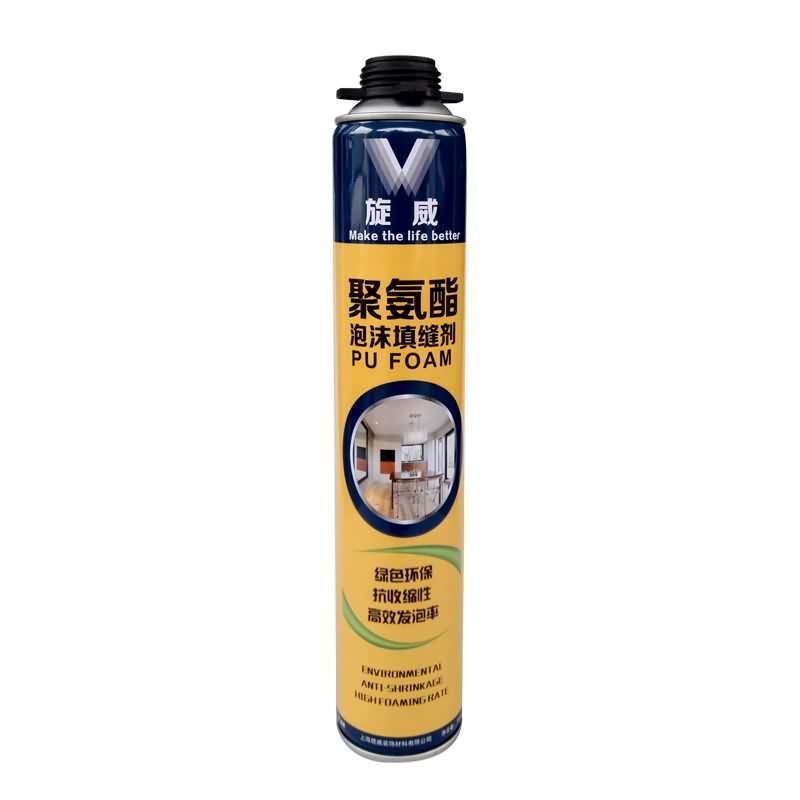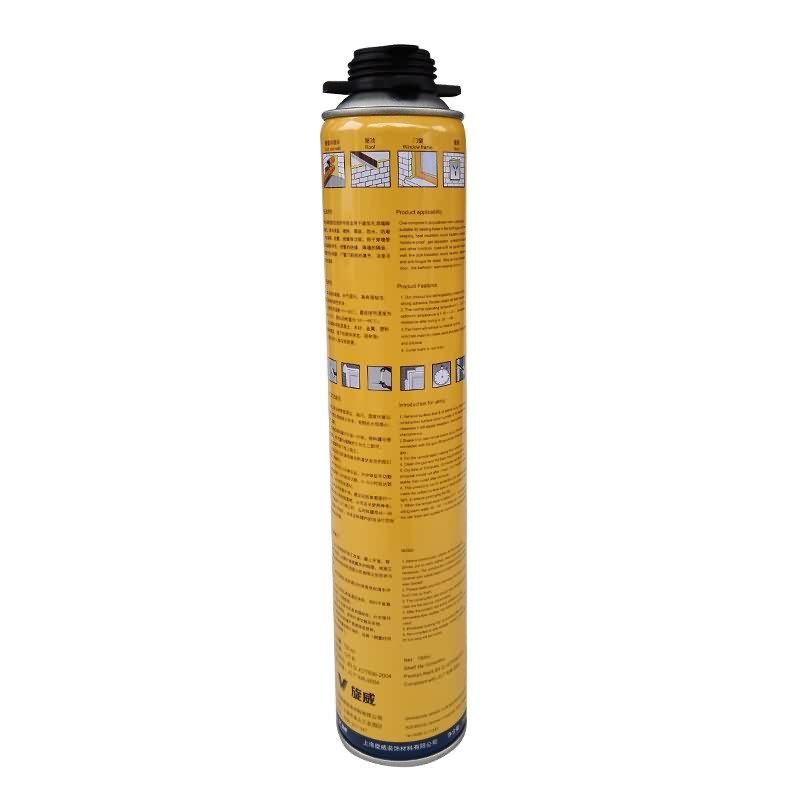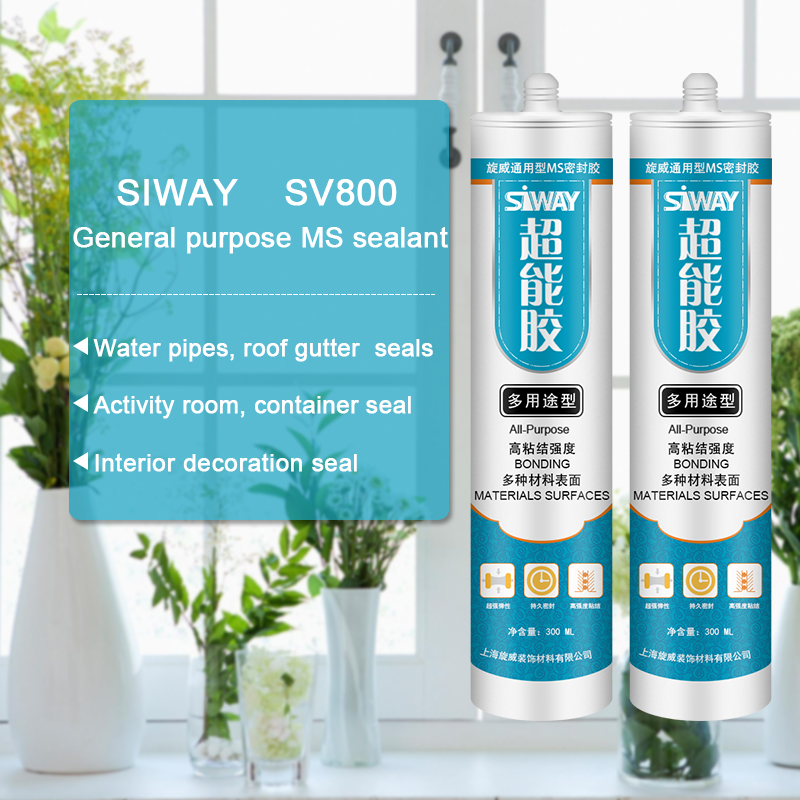17 Years manufacturer Siway PU FOAM to Indonesia Factories
Short Description:
Description This product is the expansion, moisture curing, has the strong cohesiveness, elastic foam obturator structure; Save work to save time, reduce waste; High bond strength; Bubble can stick in the concrete, wood, metal, plastic, such as base material surface, but not including teflon, silicon resins; Key Features 1. Noise silencing effect 2. Strong bonding strength 3. Water & weatherproof 4. Primerless adhesion to most building materials Basic Application 1.Doors and Windows a...
Sticking to the principle of "Super Quality, Satisfactory service" ,We are striving to be a good business partner of you for 17 Years manufacturer Siway PU FOAM to Indonesia Factories, We are always looking forward to forming successful business relationships with new clients around the world.
Description
This product is the expansion, moisture curing, has the strong cohesiveness, elastic foam obturator structure; Save work to save time, reduce waste; High bond strength;
Bubble can stick in the concrete, wood, metal, plastic, such as base material surface, but not including teflon, silicon resins;
Key Features
1. Noise silencing effect
2. Strong bonding strength
3. Water & weatherproof
4. Primerless adhesion to most building materials
Basic Application
1.Doors and Windows and wall body between the gap filling sealing, fixed bond
2.Language lab, studio, etc when decorating, gap to fill
Technical data sheet
|
Project |
Value |
||
|
Density, Kg/m³,Not less |
10 |
||
|
Thermal conductivity,35℃,W/(m·K) no more than |
0.050 |
||
|
Dimensional stability(23±2)℃,48,h no more than |
5 |
||
|
Operating temperature |
-10~+35℃ |
||
|
Optimum operating temperature |
+18~+25℃ |
||
|
Temperature range(After curing) |
-35~+80℃ |
||
|
Tensile bond strength kPa Not less |
Aluminum plate |
Standard condition,7d |
80 |
|
Immersion,7d |
60 |
||
|
PVC plate |
Standard condition,7d |
80 |
|
|
Immersion,7d |
60 |
||
|
Cement Plate |
Standard condition,7d |
60 |
|
|
Shear strength,kpa,Not less |
80 |
||
|
Foam expansion ratio,Not less |
Standard value-10 |
||
Certification
JC 936-2004
Color
White
Package
750ml in Bottle * 12 per box
Shelf life
12 months
Note
If you want the TDS or MSDS or other details, please contact with our sales person.
A how to video on how to waterproof or re-waterproof your footwear
How to hack flashlight batteries and a fire brick, into a desktop arc reaction chamber. …For hobby metal melting, and for science!
Some quick links to a few of the materials I used:
[✓] Lantern battery: https://amzn.to/2cgnKxN
[✓] Forstner Bit: https://amzn.to/2c1Ja3V
[✓] 3/8 Drill bit: https://amzn.to/2cgl6rL
Endcard Links:
Micro Welder: https://goo.gl/ZmccT9
Laser Blowgun: https://goo.gl/lu3o0M
Magic Mud: https://goo.gl/5dtyXP
Matchbox Rockets: https://goo.gl/jguunj
See What Else I’m Up To:
Instagram: https://goo.gl/C0Q1YU
Facebook: https://bit.ly/FBTheKingOfRandom
Business Inquiries: For sponsorship requests or business opportunities please contact me directly: https://www.youtube.com/thekingofrandom/about
WARNING:
Risk of electric shock, fire hazards, and toxic fumes depending on what material you’re working with. Dust from refractory brick should never be inhaled, as it can damage lungs and cause long term respiratory challenges. This project can reach temperatures in excess of 3,000ºF (1,648ºC) which is well beyond the melting point of hobbyists. Caution, care and expert planning are required to mitigate risks. Have fun, but always think ahead, and remember that every project you try is at your own risk.
Music By: Scott & Brendo (“Photographs” – Instrumental) https://bit.ly/ScottBrendoiTunes
Project Inspired By:
This project was originally inspired by Theo Grey and his book, “Mad Science”. After seeing the concept, I couldn’t find any information anywhere on the internet or in libraries about arc furnace experiments, so I set out on my own to achieve these results.
Project History & More Info:
If you’re wondering where you can get fire brick locally, try a quick Google search for “refractory materials” in your city. I called a couple of companies near me and asked if they’d sell to the general public. All of them said yes.
If you can’t find anything locally, try searching major hardwares stores online. They usually have inventory online that they don’t carry in the stores.
The insulating fire bricks I got were the 3” x 4.5” x 9” Alumina-Silicate Brick variety. I got a box of 10 for $33, effectively making them around $3.30 each. I went one step further and designed the furnace so that 2 of them could be made from one brick, cutting the cost in half, making each furnace a pro-rated $1.65 each!
They’re extremely lightweight, and capable of withstanding the temperatures used in steel working, but soft enough you can cut and carve them with kitchen utensils if you need to.
In reading and studying history a bit, I learned that some of the earliest forms of light were made using carbon arc lighting. Large amounts of electricity were pumped through carbon rods, making a bright arc and providing light.
To scavenge carbon electrodes, I took a lesson from NurdRage (youtube.com/NurdRage) a couple of years ago I saw his video on what could be scavenged from a carbon-zinc lantern battery (https://bit.ly/IBNurdRageBattery). It’s useful to know what common everyday materials are made of, and these heavy duty batteries are containers packed with carbon rods, zinc metal, and manganese dioxide. I tucked the information in the back of my mind until now.
In this project I tried melting the zinc casings from the lantern batteries, and casting them into a small ingot, formed with a mini muffin tray. Be cautious of the zinc oxide fumes produced. I haven’t personally suffered any ill effects from working with it, but some people claim it can give flu like symptoms, or a fever if inhaled in large quantities.
Zinc has a relatively low melting point 787.2°F (419.5°C), so the Arc Furnace is able to melt each casing into liquid zinc in around 5-10 seconds. That’s amazing!
I don’t have an exact purpose for the zinc yet, but it’s an easy metal to work with, easy to cast, and great to have on hand for a future projects. It’s also one of the main metals used for making a simple carbon-zinc battery.
The black stuff pulled out of the battery casings is manganese dioxide. It’s a useful chemical for experiments with hydrogen peroxide, so it’s worth hanging onto.
Although I haven’t verified it, I believe any stick welder can be used to power the mini arc furnace, and for most hobbyists, that would definitely be the easier and safer way to go. I just don’t own a welder, so I used the one I made instead. You can see how to make it here: https://goo.gl/H0FWxE
The longest I’ve run the unit continuously is around 3-4 minutes, and the electrodes get so hot at that point they can seriously burn your hands, or melt your gloves. I wouldn’t recommend running it any longer than that.







